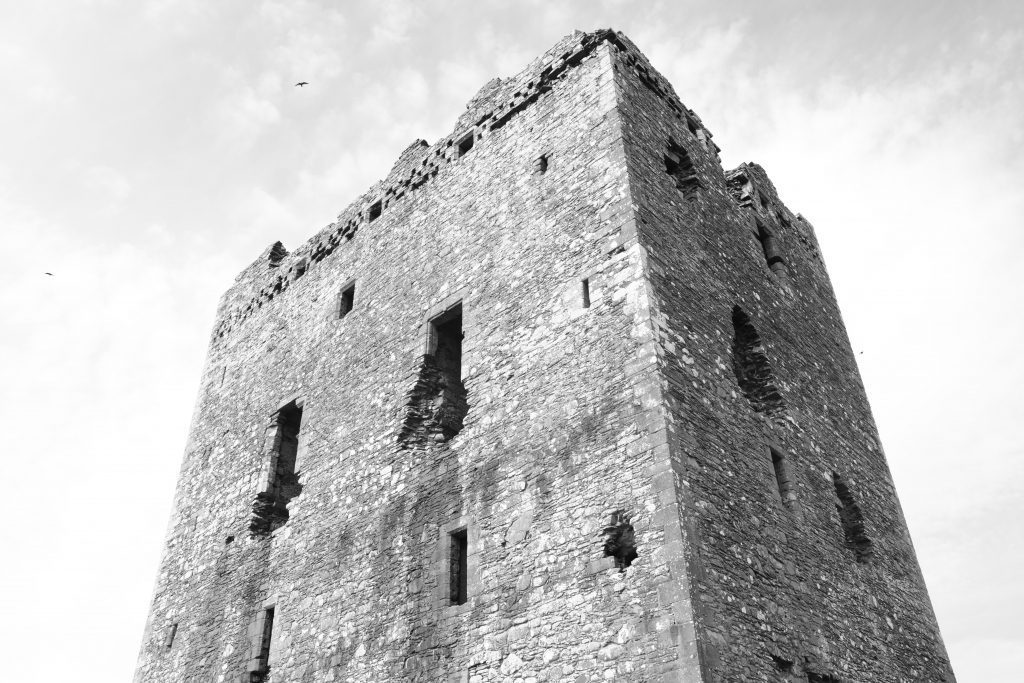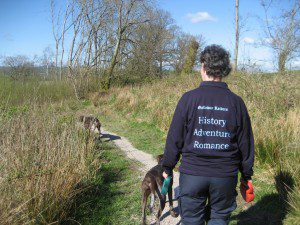What’s going On Dumfries and Galloway – S.R.Crockett slot April 2015.
A year ago this month the 100th anniversary of Crockett’s death was marked by a series of events, the re-publication of 32 of his Galloway based novels as ‘The Galloway Collection’ and the setting up of the S.R.Crockett Society ‘The Galloway Raiders.’ One year on people are beginning to catch on to Galloway’s novelist and enjoy his stories in their landscape all over again. You too can explore Crockett’s Galloway, by visiting some of the places he wrote about in his fiction.
April sees the re-opening of Threave Castle (run by Historic Scotland) which closes for the winter. Accessible only by boat, this is the stronghold of the Douglas family and is especially linked to Archibald the Grim (3rd earl of Douglas).
‘The waning moon cast a pale light across the landscape, and he could see the tents on the castle island glimmer greyish white beneath him. Beyond that again was the shining confluence of the sluggish river about the isle, and the dark line of the woods of Balmaghie opposite.’ (The Black Douglas)
Crockett wrote two novels set in and around Threave (or Thrieve) Castle. They are both set in the 15th century. The first ‘The Black Douglas’ tells the story of the Earls of Douglas, but also the ordinary folk including Sholto and Laurence McKimm, who provide the novel’s true heroism. He also offers evocative descriptions of Threave Castle itself:
‘Close by the last turn of the turret staircase yawned the iron-sparred mouth of the dungeon, in which in its time many a notable prisoner had been immured. It was closed with a huge grid of curved iron bars, each as thick as a man’s arm, cunningly held together by a gigantic padlock.’ (The Black Douglas)
Above all, this is a gothic tale where the supernatural is never far away and is strangely reminiscent of Keats ‘La Belle Dam sans Merci’. It is old-style romance, with werewolves and superstition mingling with the knights and fair maidens. On Sholto’s first night of guard duty he is scared near witless:
‘He had also a vague sense of being watched by presences invisible to him, but malign in their nature. Again and again he caught himself listening for footsteps which seemed to dog his own. He heard mysterious whisperings that flouted his utmost vigilance, and mocking laughter that lurked in unseen crevices and broke out as soon as he had passed.
His feet hardly touched the stone stairs as he flew downwards and wings were added to his haste by the sounds of fear which continued to increase. In another moment he was upon the last step of the turnpike and at the entrance of the corridor which led to the rooms of the little lady Margaret and Maud Lindsay.
As Sholto came rushing down the steep descent from the roof he caught sight of a dark and shaggy beast, running on all fours just turning out of the corridor, and taking the first step of the descent towards the floor beneath.’ (The Black Douglas)
Contemporary readers were warned against the horrors of the book, with critics suggesting ‘no one who has weak nerves should touch this book’ and ‘It is no puling, weak, milk and water sorcery Mr Crockett gives us, but the Black Art of the deepest, most genuine kind.’ While we may be used to sterner stuff, and find Crockett’s episodic style unusual at first, the rapidly paced, almost breathless story can make your head spin as it takes you on quite a journey into the past. It is more ‘Dracula’ than ‘Ivanhoe’ but shares the best of both of those and adds a unique vision of Threave in its natural environment.
The second novel , ‘Maid Margaret’ is a sequel of sorts, told through the eyes of Margaret Douglas. In ‘The Black Douglas’ we see her as a child, but in this sequel she is grown to womanhood. The Douglas/Stewart conflict is given a whole new perspective in Crockett’s novel, and through Margaret we see what it was like to be a woman in medieval times – especially one whose marriage can serve a purpose in the political arena. But Margaret is wild and petulant, more like Catherine Earnshaw in Emily Bronte’s ‘Wuthering Heights’ than anything else, and she brings a sense of reality to the dynastic powers struggles of the time, allowing the reader to feel truly involved in an individual love story.
The siege of Threave provides an absolute high point to the story, and I would recommend it to anyone visiting Threave Castle – The chapters where Margaret and her entourage shelter in the Castle’s Dungeon, ‘Archibald the Grim,’ should enliven a visit to the Castle, allowing the reader to imagine it in times gone past with a vividness that is often lacking when trying to imagine life back into a ruin.
‘Those who have only seen the castle afterwards, a desolate and marvellous ruin, towering to the skies with its riven sides and crumbled battlements, yet for all that, grimly erect in it majesty, can have no idea of the terror of these hours when the whole building seemed ready to dissolve into a heap of stones, not one remaining upon the other.’ (Maid Margaret )
Crockett also fictionalises the Siege of Roxburgh in this novel, and he offers detail on the cannon Mons Meg , in his version this is built by the MacKimms and used to devastating effect in the death of James II (Stewart).
If you want to breathe life back into Threave Castle, I can strongly recommend reading the books before or during a visit to the Castle. I can think of little better on a sunny day in April, than curling up in the walls of Threave Castle with a copy of either (or both) of these books and letting my imagination run riot. But be warned, if you don’t hear voices from the past while reading Crockett at Threave, you have no romantic soul!
If you are interested in medieval Scottish history, in the Douglas clan, or just in Theave and its place in the landscape and history of Galloway, then reading these stories after a visit will allow you to touch the parts that cameras cannot reach.
And remember, these are just two of a huge collection of fiction written by Crockett, exploring Galloway from 15th century right up to 20th century. Why not make this the year you Discover Crockett’s Galloway. Next month I’ll tell you about a new series of books which will help you do just that.
Cally Phillips
You can buy both ‘The Black Douglas’ and ‘Maid Margaret’ direct from the Galloway Raiders online store www.gallowayraiders.co.uk in paperback and ebook format, with special discounts for Galloway Raiders members. They are also available from Amazon as Volumes 1 and 2 of ‘The Galloway Collection.’
So why not give yourself a treat this spring – visit Threave as it is today and read about it as Crockett imagined its past.









